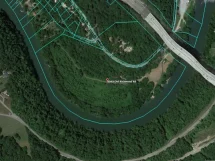Officials considering how to proceed, whether to preserve portion of sinkhole
By Lorie Hailey
lanereport.com editor
BOWLING GREEN, Ky. (May 7, 2014) — Officials at the National Corvette Museum have been busy cleaning up the damage that occurred when a 40-foot wide sinkhole collapsed Feb. 12 and swallowed eight prized sports cars. Now that all – some severely damaged and unrecognizable – have been retrieved, the questions remain: “How did this happen?” and “What now?”
Recovery and remediation team members met in April to discuss the future of the museum Skydome and assess findings by Western Kentucky University’s cave and karst team. A void found about 50 feet beneath the museum extends into two directions – one toward the museum’s truck parking lot, and the other toward an onsite pond.

“You don’t typically have sinkholes without caves or voids of some type below them, so this finding was not surprising,” Dr. Jason Polk, WKU assistant professor of geography, told museum officials.
There are dozens of known, mapped caves in the Bowling Green city limits, and more than 200 documented in Warren County – all likely thousands of years old. The recovery team reviewed the original construction documentation, when a geotechnical test completed in accordance with normal standards indicated no problems.
“Normally if there is enough rock, it doesn’t matter what is below it,” said Danny Daniel of Scott, Murphy & Daniel Construction, and rebar was not required in the concrete flooring when the Skydome was built.
The sinkhole may have been caused by the collapse of a portion of a cave roof, perhaps caused by the extra weight from clay soils above it becoming saturated by heavy rain, the team thinks.
They are exploring ways to rebuild the Skydome floor. One plan includes drilling with micro piles then adding beams to ensure the floor is secure. The museum also wants to preserve a portion of the sinkhole to sustain and share the museum’s history.
“The interest in our sinkhole and the rescued Corvettes has been more than expected, and our attendance for March was up 56 percent over March of last year,” said Wendell Strode, executive director of the museum.
A special sinkhole display in the exhibit hall will continue through the summer, including the museum’s Aug. 28-30 20th Anniversary Celebration.
General Motors reps plan to meet with museum officials this month to inspect the eight Corvettes and determine which can be restored. Those not restored will go on permanent display to tell the story of the sinkhole collapse.




















Add Comment